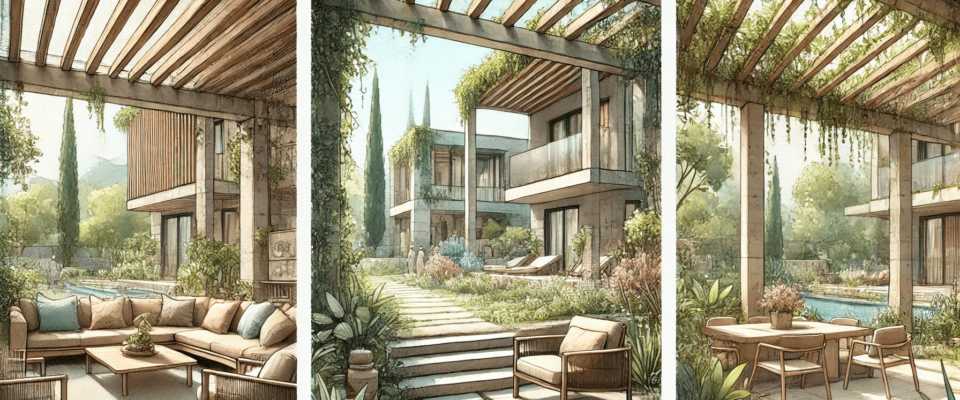A house where every corner is filled with the breath of nature and health is a dream for many. Natural building materials open the way to creating a home where every detail is in harmony with the environment. It is important to understand that the use of natural materials not only ensures environmental friendliness, but also creates a special atmosphere of comfort and warmth. Choosing natural materials is the first step towards a home that lives in harmony with nature.
In a world where concrete and plastic dominate construction, natural materials allow us to return to our roots. Wood, stone, clay – these materials create a unique atmosphere filled with natural comfort. Such a house becomes not just a living space, but also a place for recuperation and inner harmony. The use of recycled materials can further enhance the environmental aspect of construction. It is importantto understand that the use of these materials also contributes to better health and well-being.
Natural materials have the ability to breathe, which is especially important for creating a healthy microclimate. They provide natural ventilation and humidity control, which makes the house comfortable at any time of the year. In addition, such materials have high durability and stability, which makes them ideal for creating sustainable and eco-friendly housing. It is important to note that natural materials also help to reduce energy costs for heating and cooling the house.
The path to harmony with nature
The choice of natural materials for building a house opens up new horizons in creating a living space. Wood, stone and other natural materials not only create a unique appearance, but also provide a high quality of life inside the house. Due to their natural properties, they contribute to creating an optimal microclimate and maintaining the health of residents.
These materials allow you to breathe not only the house, but also its inhabitants. Natural materials create natural ventilation, which prevents the accumulation of harmful substances in the air. Such a house becomes a safe and cozy place to live, where every corner is filled with freshness and natural harmony. The effect of “breathing” walls is especially valuable for those who want to create a space that promotes well-being.
In addition, the use of natural materials helps to reduce the carbon footprint and reduce the impact on the environment. Such houses become an example of a responsible attitude to nature and inspire the creation of a sustainable future. Natural materials are not just a trend, but a conscious choice in favor of ecology and health.
Advantages of using natural building materials
The use of natural building materials gives the house unique aesthetic and practical qualities. Materials such as wood and stone not only enhance the appearance of the home, but also add a unique charm and warmth to its atmosphere. These materials are known for their ability to create a healthy indoor climate by regulating humidity and air cleanliness. Natural materials do not emit harmful substances, which makes the house a safe place to live.
The use of natural materials contributes not only to improving air quality, but also to the overall well-being of the inhabitants. Eco-friendly materials reduce the risk of developing allergies and other diseases. This is especially important for families with small children or sensitive people. Due to their heat-insulating properties, natural materials also help reduce energy costs, keeping you warm in winter and cool in summer.
Durability is one of the key advantages of natural building materials. Unlike their artificial counterparts, materials such as wood and stone stand the test of time, which makes investing in such construction profitable. In addition, natural materials are easily restored and maintained, which ensures the preservation of appearance and functionality for many years to come.
Important aspects of using natural building materials can be further supported by the following list:
- Aesthetic appeal. Natural materials add uniqueness and style to the home.
- Environmental sustainability. Reduce environmental impact and maintain biodiversity.
- Healthy microclimate. Maintaining an optimal balance of humidity and cleanliness of the indoor air.
- Energy efficiency. Reducing the need for artificial heating and cooling due to the natural properties of materials.
These advantages highlight the importance of choosing natural materials for building and supporting a sustainable lifestyle.
Aesthetics and harmony in the interior
The use of natural materials in the interior of the house creates a unique atmosphere of comfort and harmony. Each element, whether it is a wooden floor or stone walls, brings warmth and naturalness to the space. These materials are not only visually appealing, but also contribute to improving the overall well-being of the inhabitants. Natural materials create a connection with nature, making the house a place where you can feel part of the world around you.
Harmony in the interior is also achieved thanks to natural colors and textures that do not tire the eye and create a calm atmosphere. A color palette based on natural hues helps maintain balance and harmony in the living space. The textures of wood, stone and other natural materials add tactile sensations and make the interior more layered and interesting. It is thanks to these elements that the interior of the house becomes a reflection of nature.
The use of natural materials in the interior contributes to the creation of a long-term style that will be relevant for many years. Such materials retain their appeal and only get better over time, acquiring unique features. Their natural durability and wear resistance ensure long-term aesthetic enjoyment and comfort for the occupants of the house. Natural materials create an interior that will delight the eye and warm the soul every day.
Environmental impact
Construction using natural materials has minimal impact on the environment. Materials such as wood and stone have a low carbon footprint, making them an environmentally responsible choice. The choice of these materials also supports sustainable development, as they are renewable resources. Maintaining a natural balance in the construction and operation of a home is becoming a key aspect of a sustainable lifestyle.
The environmental friendliness of natural materials is evident not only at the construction stage, but also throughout the entire service life of the house. Due to their natural properties, they do not require significant maintenance and repair costs, which reduces resource consumption. The use of natural materials also helps to reduce the amount of waste, as they are easily recyclable and do not pollute the environment.
Choosing natural materials for home construction and decoration is an important step towards a more sustainable future. Each element of the house, created from naturalmaterials, helps to preserve the ecosystem and improve the quality of life of its inhabitants. Natural materials help not only to create a cozy home, but also to preserve the planet for future generations.
Questions and answers
Natural materials maintain optimal humidity levels and provide natural ventilation.
These materials create a harmonious atmosphere and retain their appeal for many years to come.
They have a low carbon footprint and support sustainable development.

